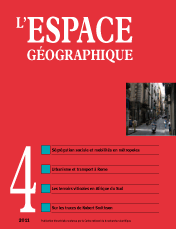

Luxembourg: Cross-border metropolisation and socio-spatial specialization: the spatial concentration of knowledge-intensive workers (7 fig., 3 encadrés, 3 tabl.)
Over the past two decades, Luxembourg has emerged as a small, yet highly specialized metropolis with an expanding cross-border functional area. Generally, this process tends to go hand-in- hand with socio-spatial specialization. This research therefore aims to investigate the spatial concentration of Knowledge-Intensive Services and Hightechworkers in the residential cross-border area, using exploratory spatial data analysis methods. The results show residential clusters of KIS and High-tech workers in and around the main urban centres in 1999 and along the main transport routes connecting these urban centres in 2008. The border and the transport routes therefore appear as driving forces in socio-residential recomposition.
keywords: BORDER, KIS AND HI-TECH WORKER, LUXEMBOURG, RESIDENTIAL CONCENTRATION, SPATIAL AUTOCORRELATION
The location of upper-class residential areas in Southern European cities: the case of Naples (8 fig., 1 photo)
Although upperclass residential segregation is very marked in Western cities, it has not been widely studied. Researchers have focused on specific high-status groups or areas, but they have rarely explored the general pattern of upper-class locations in a whole city. Based on quantitative data and field work, this paper presents a typology and a synthesis map of elite residential locations in Naples metropolitan area, and describes changes occurring between 1861 and 2001. This work has demonstrated that the classic gentrification processes observed in Western cities, linked to the development of metropolises, do not apply in Naples. Because of the decline of the city, the elites still tend to concentrate around the inner city traditional high-status areas.
keywords: ELITE, ITALY, SOCIAL GEOGRAPHY, URBAN GEOGRAPHY
Metropolitan process and residential segregation. The migration flows in the Provence-Alpes-Côte d’Azur region (France) (10 fig.)
This paper proposes a joint analysis of residential mobility and the concentration of selected target populations in the Provence-Alpes-Côte d’Azur region, France. The link between the emergence of metropolitan areas and residential segregation is examined. The analyses are based on location quotients and dominant flows of residential mobility. They show marked spatial differences across the residential patterns of the target populations. The most remarkable divide concerns managerial and executive workers and the unemployed, who appear to avoid each other, generating segregated spatial configurations. The results also show the complexity of the spatial configurations produced by the target populations, as well as the sensitivity to particular local features.
keywords: DOMINANT FLOW, LOCATION QUOTIENT, METROPOLISATION, PROVENCE-ALPES-COTE D’AZUR, RESIDENTIAL MOBILITY, SEGREGATION
Between terroir and territory, the rebirth of the South African vineyard (3 fig., 4 photos, 1 tabl.)
Its relatively old appellation system and its post-apartheid political features make South Africa a very complex “wine producing” case study. The European tradition, led to a fairly elaborate but littleused demarcation or appellation system across the South African winegrowing territory. Nevertheless, wine “frontiers” are active across the geography of South African vineyards with an extensive use of “terroir” and geographical origin to promote new wines. The notion of the “terroir” is mainly mobilised for marketing purposes rather than to promote the geographical origin of a wine.
keywords: GUARANTEED VINTAGE, SOUTH AFRICA, TERROIR, VINEYARD, WINE FRONTIER
The cura del ferro in Rome (the rail solution): difficulties articulating urban planning and transport (4 fig., 1 photo, 1 tabl.)
Based on the development of a dense urban fabric around railway infrastructures, the “cura del ferro” (or the rail solution) introduced in Rome between 1993 and 2008 subscribes to the ‘‘Rhine urban model’’ as a new paradigm for urban planning in major European cities. However, in Rome, urban densification has come up against numerous obstacles: desynchronized developments, institutional conflicts and discrepancies between planning documents and the operational scope of public stakeholders. This case study points to the need to plan sustainable public policies in the light of territorial legacies.
keywords: DENSIFICATION, PUBLIC TRANSPORT, ROME, SUSTAINABLE URBAN DEVELOPMENT, TOWN PLANNING, URBANISATION
«A Tour of the Monuments of Passaic» (1967), the image of the city according to Robert Smithson (6 photos)
We would like to discuss the famous travelogue that the American artist Robert Smithson wrote in 1967 about his tour of the city of Passaic, New Jersey, by repositioning his reflection back in the historical context of the vast urbanistic debate aroused, towards the end of the 1950s and throughout the 1960s, by the intensification of the urban phenomenon in the United States. We would like to demonstrate how Smithson challenged the undifferentiated and disorienting nature of this typical American suburban landscape by choosing – or by having the visitor choose – a certain number of elements as “monuments”. By choosing these “monuments”, no matter how trivial, transitory and subjective they were, the artist created a number of landmarks that helped to structure people’s apprehension of this urban fabric.
keywords: CONTEMPORARY ART, MONUMENT, ROBERT SMITHSON, TRAVELOGUE, URBANISM
L’espace géographique 3/11![]()
![]() L’espace géographique 1/12
L’espace géographique 1/12
For subscribe or buy this issue: BELIN
![]() L’Espace géographique: contents
L’Espace géographique: contents
Last modified: April 2, 2013